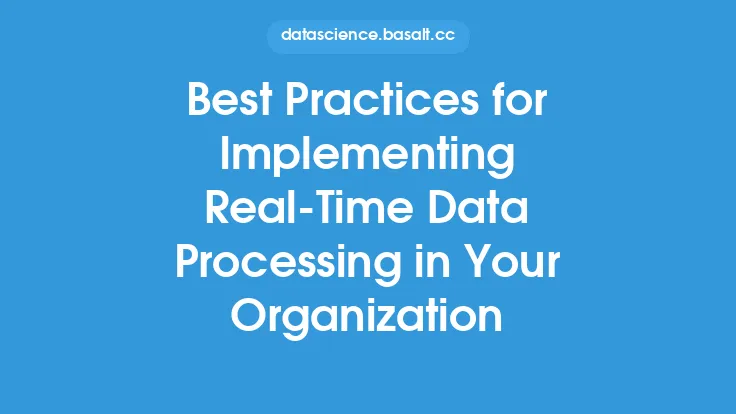Implementing model interpretability in real-world applications is a crucial step in ensuring that machine learning models are transparent, accountable, and reliable. As machine learning continues to play an increasingly important role in various industries, the need for model interpretability has become more pressing than ever. In this article, we will discuss the best practices for implementing model interpretability in real-world applications, highlighting the key considerations, techniques, and tools that can be used to achieve this goal.
Introduction to Model Interpretability
Model interpretability refers to the ability to understand and explain the decisions made by a machine learning model. This involves identifying the relationships between the input features and the predicted outcomes, as well as understanding how the model is using the data to make predictions. Model interpretability is essential in real-world applications, as it enables stakeholders to trust the model's decisions, identify potential biases, and improve the model's performance over time.
Key Considerations for Implementing Model Interpretability
When implementing model interpretability in real-world applications, there are several key considerations that must be taken into account. These include:
- Model complexity: The complexity of the model can significantly impact its interpretability. Simple models, such as linear regression, are generally easier to interpret than complex models, such as neural networks.
- Data quality: The quality of the data used to train the model can also impact its interpretability. Noisy or missing data can make it difficult to understand the relationships between the input features and the predicted outcomes.
- Stakeholder needs: The needs of the stakeholders who will be using the model must also be considered. For example, non-technical stakeholders may require simpler, more intuitive explanations of the model's decisions, while technical stakeholders may require more detailed, technical explanations.
Techniques for Implementing Model Interpretability
There are several techniques that can be used to implement model interpretability in real-world applications. These include:
- Feature importance: This involves identifying the most important input features that are driving the model's predictions. Techniques such as permutation importance and SHAP (SHapley Additive exPlanations) can be used to calculate feature importance.
- Partial dependence plots: These plots show the relationship between a specific input feature and the predicted outcome, while holding all other input features constant.
- Local interpretable model-agnostic explanations (LIME): This technique involves training a local, interpretable model to approximate the predictions of the original model, for a specific instance or subset of instances.
- Model-agnostic interpretability methods: These methods can be used to interpret any machine learning model, regardless of its type or complexity. Examples include model-agnostic feature importance and model-agnostic partial dependence plots.
Tools for Implementing Model Interpretability
There are several tools that can be used to implement model interpretability in real-world applications. These include:
- Python libraries: Libraries such as scikit-learn, TensorFlow, and PyTorch provide a range of tools and techniques for implementing model interpretability.
- R libraries: Libraries such as caret and dplyr provide a range of tools and techniques for implementing model interpretability in R.
- Interpretability platforms: Platforms such as H2O and DataRobot provide a range of tools and techniques for implementing model interpretability, including feature importance, partial dependence plots, and model-agnostic interpretability methods.
Best Practices for Implementing Model Interpretability
To ensure that model interpretability is implemented effectively in real-world applications, several best practices must be followed. These include:
- Start with simple models: Simple models, such as linear regression, are generally easier to interpret than complex models, such as neural networks.
- Use model-agnostic interpretability methods: Model-agnostic interpretability methods can be used to interpret any machine learning model, regardless of its type or complexity.
- Consider stakeholder needs: The needs of the stakeholders who will be using the model must be considered, and the interpretability techniques used must be tailored to meet those needs.
- Monitor and update the model: The model must be continuously monitored and updated to ensure that it remains accurate and reliable over time.
Challenges and Limitations of Implementing Model Interpretability
While implementing model interpretability is crucial in real-world applications, there are several challenges and limitations that must be considered. These include:
- Model complexity: Complex models, such as neural networks, can be difficult to interpret, even using model-agnostic interpretability methods.
- Data quality: Noisy or missing data can make it difficult to understand the relationships between the input features and the predicted outcomes.
- Stakeholder buy-in: Stakeholders may be resistant to using interpretability techniques, or may not understand the benefits of model interpretability.
- Computational resources: Implementing model interpretability can require significant computational resources, particularly for large and complex models.
Future Directions for Model Interpretability
As machine learning continues to evolve, the need for model interpretability will only continue to grow. Future directions for model interpretability include:
- Developing new interpretability techniques: New techniques, such as attention-based interpretability methods, are being developed to provide more accurate and reliable interpretations of machine learning models.
- Improving model-agnostic interpretability methods: Model-agnostic interpretability methods, such as SHAP and LIME, are being improved to provide more accurate and reliable interpretations of machine learning models.
- Increasing stakeholder awareness: Stakeholders must be educated about the benefits of model interpretability, and the importance of using interpretability techniques in real-world applications.
- Developing more efficient computational methods: More efficient computational methods, such as parallel processing and distributed computing, are being developed to reduce the computational resources required for implementing model interpretability.





